5 Exercises That Boost Testosterone DRAMATICALLY
Fact Checked On: 1-7-2022 By: Rob MillerIt’s no secret, exercising is one of the best ways to help increase your bodies natural production of testosterone.
With that said, you can’t just do any old exercise and expect to get huge results.
There are specific exercises that work way better than others when it comes to increasing testosterone.
The 5 exercises below are the ones you should be focused on the most to get the best results.
Update! 5-7-2021
If you’re looking for a REAL solution to your ED issues, check out a product called Vigrx Plus.
It’s an effective erectile dysfunction tablet that is by FAR the best natural ED remedy on the market.
Click Here to read my full review.
On the other hand, if you’re looking for an effective testosterone boosting supplement, check out a product called Prime Male.
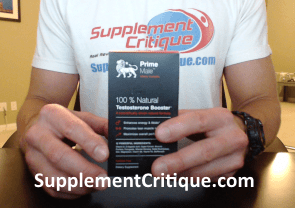
It’s by far the most effective all-natural Testosterone boosting supplement we’ve tested to date, and we’ve tested 100’s of them.
Click Here to read my full review of Prime Male.
Now, onto the rest of the article.
Contents
Exercise and Testosterone: What’s the Connection
Does Exercise Boost Testosterone
What Type of Exercise is Best to Increase Testosterone
Top 5 Exercises to Increase Testosterone
Best Testosterone Workout
Worst Types of Exercise for Testosterone Levels
The Science of Low Testosterone and Endurance Training
Is All Running Bad for Your Testosterone
We are living in a time in history where men are more overweight than they’ve ever been and also have the lowest levels of testosterone.
Are you starting to see a connection here?
With the ramping up of technology and jobs that require you to sit for up to 10 hours, our physical activity level as a global population has steadily decreased.
The lack of physical activity is the worst in the most developed countries.
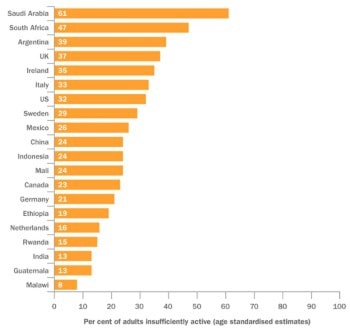
What’s more, environmental estrogens have become a big problem that no one seems to be actively addressing.
Soy in our food supply and estrogen-spiking chemicals in the objects we use each day have created a hormonal nightmare for our bodies.
A response to this has been Testosterone Replacement therapy but most people, rightly so, want to avoid the insane cost and unpredictable results.
One of the most proven and most effective ways to boost testosterone levels may be down the street at your local gym.
Update! 11-18-2020
If you’re looking for a REAL solution to your ED issues, check out a pill called Blue Chew.
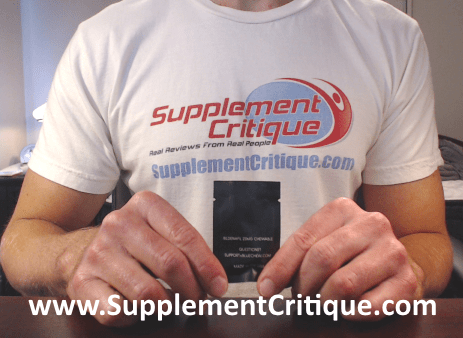
It’s an effective erectile dysfunction tablet that is by FAR the best ED remedy on the market.
Click Here to read my full review.
Exercise and Testosterone: What’s the Connection?
You’re probably fully aware that exercise is recommended by all medical professionals to improve and maintain great overall health. Science has shown that performing a consistent and appropriate exercise program helps to support cardiovascular health, promote weight management, and build lean muscle mass.
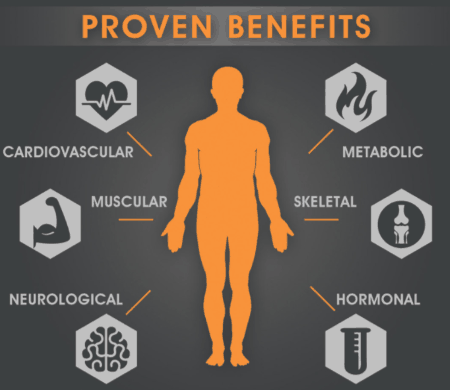
Resistance training, in particular, is said to be one of the best ways to ensure a high quality of life well into your old age.
Weight lifting, calisthenics, and power-driven sports training are great examples of resistance training.
What does exercise do for you on a hormonal level?
Is it an effective way to increase testosterone levels?
Here’s what the science says:
Does Exercise Boost Testosterone?
What the Science Says
In the journal of Mechanisms of Ageing and Development, young adults (23 years old) and elderly (63 years old) subjects were put on a 12-week resistance training program.
They performed workouts on Nautilus equipment that activated all of the major muscle groups.
The workouts ranged from 45 to 60 minutes.
At the conclusion of the 12-week program, researchers observed that both young adults and elderly subjects had higher levels of testosterone and growth hormone.
While the elderly didn’t have as high of a response as the young adults, it was still a positive result. (1)
The study from above was performed in 1989 and those finding have been replicated several times over.
For example, a study published in the International Journal of Sports Medicine took a group of young adults and elderly subjects and assigned them to a strength endurance workout made up of six exercises.
Just like the study in 1989, this exercise activated all of the major muscle groups.
The acute variables were three sets of 15 reps at 60% one-repetition maximum.
The results?
Both the young and older subjects saw increases in testosterone and growth hormone. (2)
Considering the science behind the influence of exercise on testosterone levels and the consistent positive response, I think it’s safe to say that if you want to increase those low t-levels, you need to start spending more time near the iron.
What Type of Exercise is Best to Increase Testosterone
Are you ready to get started but you’re not sure which type of exercises are ideal for boosting testosterone levels?
With the hundreds of exercises that are out there, it’s no wonder you may feel overwhelmed.
When in doubt, look towards the science.
The best type of exercise to perform to increase testosterone is compound movements.
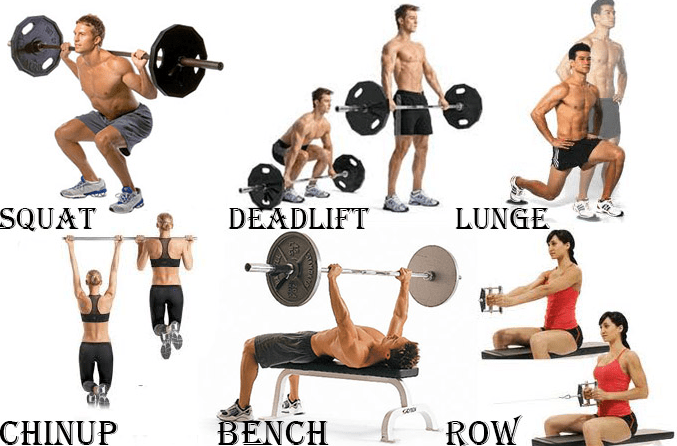
Compound exercises are those movements that engage the greatest numbers of muscle groups in one workout.
Think back to the studies above: whether it was based around machines or free-weights, each workout engaged all of the major muscle groups.
In order to trigger the greatest release of testosterone and growth hormone, you’ll want to find those exercises that round-up several big muscle groups at once.
The major movers are the chest, back, quadriceps, hamstrings, shoulders, and abdominals.
Are there exercises that activate all of these muscles at once?
Top 5 Exercises to Increase Testosterone
Deadlifts
- Muscles activated: Hamstrings, lower back, calves, quadriceps, hip flexors, core
Demonstration video:
[youtube https://www.youtube.com/watch?v=MDuXuUg15mk]
Squats
- Muscles activated: Quadriceps, hamstrings, calves, glutes, hip flexors, core
Demonstration video:
[youtube https://www.youtube.com/watch?v=ygj6XjDHX9s]
Lunges
- Muscles activated: Quadriceps, hamstrings, calves, glutes, hip flexors, core
Demonstration video:
[youtube https://www.youtube.com/watch?v=QF0BQS2W80k]
Barbell Rows
- Muscles activated: Back, biceps, core, hamstrings
Demonstration video:
[youtube https://www.youtube.com/watch?v=vmHbJ_JmUS4]
Clean and Press
- Muscles activated: Shoulders, core, quadriceps, hamstrings, calves, hip flexors, core
Demonstration video:
[youtube https://www.youtube.com/watch?v=e_OGoQ94mPQ]
Best Testosterone Workout
Perform this workout up to three times per week:
Deadlifts: 5 sets of 8 to 12 repetitions
Squats: 5 sets of 8 to 12 repetitions
Lunges: 3 sets of 12 to 15 repetitions
Barbell Rows: 5 sets of 8 to 12 repetitions
Clean and Press: 3 sets of 8 to 12 repetitions
Worst Types of Exercise for Testosterone Levels
Some of you may inevitably be reading this, thinking of your own fitness routine, and realize that you aren’t doing any of those exercises.
If you’re current workout program involves a lot of running then this next section is especially important.
Endurance training, while great for supporting cardiovascular health, promoting weight management, and reducing your risk for disease, may not be a good thing for your testosterone levels.
What qualifies as endurance training?
You naturally build some endurance when working out but endurance training is focused specifically on maximizing the efficiency of the muscle for long durations of time.
The best example of this is when a runner is training for a marathon. (For the non-runners, a marathon is 26 miles.)
Can you imagine bothering to ride in a car for 26 miles, let alone running that far?
Marathon running takes a lot of endurance training in the form of gradual increases in running-center workouts and carbohydrate timing.
Big muscle mass is more often than not absent from a marathon runner’s frame but the capacity at which that super lean mass can perform is incredible.
However, all of the endurance training that a runner goes through has a direct negative impact on testosterone levels.
Think about the difference between a marathon runner and a sprinters body.
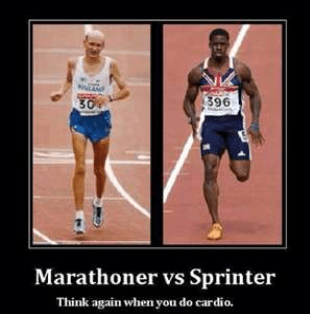
Don’t believe me?
Let’s hear what the science says:
The Science of Low Testosterone and Endurance Training
Researchers have proven time and time again that endurance training is harmful to the reproductive systems of women. This has everything to do with the work load on the body and the low percentage of total body fat.
Scientists also suspected that this same type of training would have a negative impact on men and they were right.
One study in the journal of Sports Medicine showed the on average, those men who had been undergoing endurance training for whatever fitness goal had lower testosterone levels when compared to men who were not doing any type of endurance training. (3)
The science of why endurance training results in low testosterone levels is connected to the release of cortisol during extended periods of training.
Fitness experts across the spectrum will advise you to keep your workouts within a 60 to 75-minute timeframe.
Why?
Because of cortisol.
Cortisol is a catabolic hormone, which means it likes to break things down, namely your muscle tissue.
When you exercise for hours at a time like with endurance training, you are triggering a greater release of cortisol.
When cortisol levels are consistently high in the body, studies have shown that testosterone levels are usually down.
A perfect example of the relationship of cortisol and testosterone can be seen with modern day bodybuilders.
Mass monsters require hours in the gym and yet they want to avoid the cortisol-focused consumption of protein and lean tissue.
This is why so many bodybuilders supplement with a cortisol blocker.
Is All Running Bad for Your Testosterone?
No, not at all.
If you have running penciled in as a part of your warm-up, cool-down, or cardio-day, you’ll be fine.
A light jog, running session, or short bout of sprints isn’t going to zap all of your testosterone.
It’s when you start training for super long distances that you have to be aware of your testosterone levels.
If you’re a dedicated marathon-runner who has no intentions on quitting any time soon, consider tweaking your diet to include more testosterone-building foods like eggs, coconut oil, and herbs.
You can also start supplementing with zinc to support recovery and hormone levels.
References
- Craig BW, Brown R, Everhart J.
Effects of progressive resistance training on growth hormone and testosterone levels in young and elderly subjects.
Mech Ageing Dev. 1989 Aug;49(2):159-69. - Smilios I, Pilianidis T, Karamouzis M, Parlavantzas A, Tokmakidis SP.
Hormonal responses after a strength endurance resistance exercise protocol in young and elderly males.
Int J Sports Med. 2007 May;28(5):401-6. Epub 2006 Oct 6. - Hackney AC.
Endurance training and testosterone levels.
Sports Med. 1989 Aug;8(2):117-27.
Check Out My Top Choice For Testosterone Boosters Here!! (Must Read)





